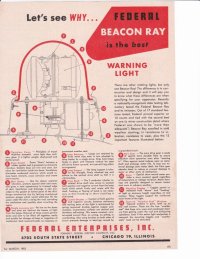Hello everyone. I have a few questions about the domes for the Beacon Ray series (Models 17, 173, 174, 175, 176).
1) From an *overall* durability standpoint, which is considered more robust? The glass is obviously heavier, but glass is glass, and (obviously) is prone to breakage.
2) Is overheating, or heat in general an issue when using either a plastic or glass dome? We are, after all, talking about anywhere from 2 to 4 incandescent lamps basically the size of headlights crammed together in a small, sealed space.. Hence my curiosity.
3) Which was more prevalent on emergency vehicles back in the day?
Thanks!
1) From an *overall* durability standpoint, which is considered more robust? The glass is obviously heavier, but glass is glass, and (obviously) is prone to breakage.
2) Is overheating, or heat in general an issue when using either a plastic or glass dome? We are, after all, talking about anywhere from 2 to 4 incandescent lamps basically the size of headlights crammed together in a small, sealed space.. Hence my curiosity.
3) Which was more prevalent on emergency vehicles back in the day?
Thanks!


